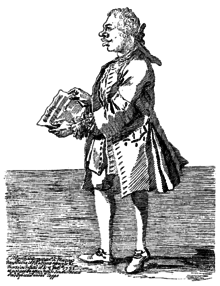Lo frate 'nnamorato
| Giovanni Battista Pergolesi |
|---|
|
Operas
|
Lo frate 'nnamorato (Neapolitan: The Brother in Love) is a three-act commedia musicale (a form of opera buffa) by Giovanni Battista Pergolesi, to a Neapolitan libretto by Gennaro Antonio Federico, first performed in 1732.
Composition history
The opera, written when the composer was only 22, is his first attempt at comic opera. (It was followed in 1733 by his better-known short opera, La serva padrona). The first performance was on 27 September 1732, at the Teatro dei Fiorentini, Naples. A successful run was halted by a severe earthquake, which closed the theatres in Naples until the autumn of 1733. It was re-presented during the 1734 carnival season, in a version revised by the author.
Roles

| Role | Voice type[1] | Premiere cast[2] 27 September 1732 |
|---|---|---|
| Marcaniello, an elderly Neapolitan | bass | Giacomo D'Ambrosio |
| Ascanio, his adopted son | soprano (in travesti) | Teresa Passaglioni |
| Luggrezia, his daughter | contralto | Rosa Gherardini |
| Don Pietro, Marcaniello´s son | bass | Girolamo Piani |
| Carlo, a Roman | tenor | Giovanni Battista Ciriaci |
| Nina, his niece | contralto | Teresa De Palma [3] |
| Nena, his niece | soprano | Marianna Ferrante |
| Vannella, Carlo's maidservant | soprano | Margherita Pozzi |
| Cardella, Marcaniello's maidservant | soprano | Maria Morante[4] |
Synopsis
The opera is set in the house of Marcaniello in the Capodimonte region of Naples. Ascanio, the brother of Nina and Nena, was stolen by brigands in childhood and presumed lost; he was however found and adopted by Marcaniello. Now Nina and Nena are the wards of their uncle, the Roman Don Carlo. Don Carlo wishes to marry Luggrezia, the daughter of Marcaniello, who himself wishes to marry Nina and to take Nena as wife for his son, the foppish Don Pietro. Nina and Nena meanwhile have fallen in love with Ascanio, not realising their relationship. The two maids Vanella (servant of Carlo) and Cardella (servant of Marcaniello) comment on and take part in the various intrigues which ensue. Finally, in a duel with Carlo, the latter recognises Ascanio as his lost nephew by a birthmark on his arm. Ascanio and Luggrezia are now free to marry.
Recordings
key: conductor / nena/nina/luggrezia/ascanio/carlo/marcaniello/pietro
- Cillario/Girones/Cavicchioli/Cavicchioli/Bonisolli/Lazzari/Mariotti/Basiola - 1969, live in Naples - Memories
- Riccardo Muti Felle/Manca di Nissa/d’Intino/Focile/di Cesare/Corbelli/de Simone - 1989, filmed at Teatro alla Scala in Milan - Opus Arte DVD
- Fabio Biondi Biccirè/Adamonyte/di Castri/Belfiore/Alegret/Alaimo-N/Morace - 2011, filmed in Jesi - Arthaus DVD
Notes
References
- (Italian) Raffaele Mellace, Frate 'nnamorato, Lo, in Piero Gelli and Filippo Poletti (editors), Dizionario dell'opera 2008, Milan, Baldini Castoldi Dalai, 2007, pp. 520–523, ISBN 978-88-6073-184-5 (reproduced at Opera Manager)
External links
- Ogni pena più spietata (aria from Act 1 of the opera) sung by Janet Baker.